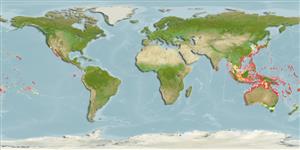Common names from other countries
>
Eupercaria/misc (Various families in series Eupercaria) >
Labridae (Wrasses) > Corinae
Etymology: Coris: Greek, kore, -es = pupil and also with themenaing of "maid" (Ref. 45335).
More on author: Fowler.
Environment: milieu / climate zone / depth range / distribution range
Ecologia
marinhas associadas(os) a recifes; intervalo de profundidade 2 - 40 m (Ref. 37816). Tropical
Western Pacific: Sagami Bay, Honshu south to Victoria, Australia and New Caledonia and east to Tonga.
Tamanho / Peso / Idade
Maturity: Lm ? range ? - ? cm
Max length : 38.0 cm TL macho/indeterminado; (Ref. 90102)
Espinhos dorsais (total) : 9; Raios dorsais (total) : 12; Espinhos anais: 3; Raios anais : 12. Body greenish with pink longitudinal lines and white barring (Ref. 48636). Body greenish with several red stripes breaking into spots posteriorly and about 8 thin vertical pale bars. A black spot rimmed with yellow on posterior margin of opercle. A black spot at posterior basal portion of dorsal fin. First 2 dorsal-fin spines with flexible tips slightly longer than other dorsal-fin spines (Ref 9823).
Found in coastal to outer reef habitats in deep gutters or along reef margins (Ref. 48636). Inhabits rocky and coral reefs, in areas with rubble, weed and sand (Ref. 9710). Found solitary (Ref. 90102).
Ciclo de vida ou comportamento de acasalamento
Maturities | Reprodução | Spawnings | Egg(s) | Fecundities | Larvas
Oviparous, with distinct pairing during breeding (Ref. 205).
Randall, J.E., 1999. Revision of the Indo-Pacific labrid fishes of the genus Coris, with descriptions of five new species. Indo-Pac. Fish. (29):74 p. (Ref. 33411)
Status na Lista Vermelha da UICN (Ref. 130435)
CITES (Ref. 128078)
Not Evaluated
Ameaça para os humanos
Harmless
Uso pelos humanos
Pescarias: espécies comerciais; Aquário: Espécies comerciais
Ferramentas
Relatórios especiais
Baixar XML
Fontes da internet
Estimates based on models
Preferred temperature (Ref.
115969): 22.4 - 28.9, mean 27.5 (based on 532 cells).
Índice de diversidade filogenética (Ref.
82804): PD
50 = 0.5000 [Uniqueness, from 0.5 = low to 2.0 = high].
Bayesian length-weight: a=0.00977 (0.00470 - 0.02030), b=3.07 (2.89 - 3.25), in cm Total Length, based on LWR estimates for this (Sub)family-body shape (Ref.
93245).
Nível Trófico (Ref.
69278): 3.5 ±0.3 se; based on size and trophs of closest relatives
Resiliência (Ref.
120179): médio(a), tempo mínimo de duplicação da população 1,4 - 4,4 anos (Preliminary K or Fecundity.).
Fishing Vulnerability (Ref.
59153): Low to moderate vulnerability (28 of 100).
